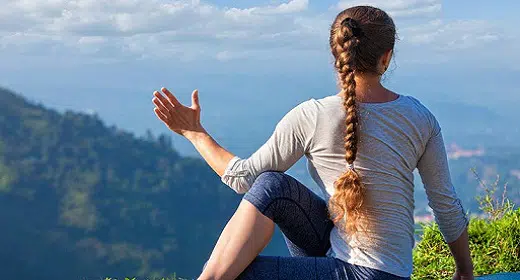by Tiffany Cruikshank: Nervous about twisting? The movement can actually benefit your spine and back. Here’s why…
If you’ve ever experienced significant back pain, twists may be a group of yoga poses you shy away from, and rightfully so. I, too, used to feel nervous in twisting poses after a disc injury a dozen years ago. But after learning the power and potential of these yoga poses both in my own body and with the students and teachers I work with, I’ve since shifted my approach.
Much like any good medicine, twists need to be taken in the proper dosage. But I’ve found that yoga—and twisting poses in particular—can alleviate back pain and discomfort when done correctly.
Your spine in twisting poses
Your spine is made to move in all directions, and generally speaking, movement is important to keep the spine healthy (make sure to consult a healthcare provider before starting any exercise regimen if you have back pain). In fact, the discs wedged between your vertebrae are dependent on movement for circulation. The discs are avascular, which means they don’t get direct blood supply. Instead, they rely on a mechanism called “imbibing,” in which the changing pressures around the discs cause them to drink up or take in nearby fluids. This fluid is what keeps the discs healthy and plump (think the opposite of degenerative discs) and creates separation between the vertebrae for range of motion. Twists are the perfect way to shift pressure through the discs and help support this process. For those sensitive to twists, this doesn’t require deep movement, but a mindful attention to find a gentler variation.
Besides listening to your body and going gently, one of the most important things to pay attention to is the support within the pose, whether that be with props or muscular engagement. Luckily, when you’re laying on your back, much of the pressure is taken off the spine as you rest on the floor. Here, you can rely more on props for support as you relax. When you’re upright, it’s more important to create active support around the abdominal wall for the spine and discs. Enter the transversus abdominis (TvA), a subtle but important muscle that wraps all the way around the waist to connect to the fascia of the six-pack abs on the front and the fascia of the ropey erector muscles running down each side of the spine on the back. You can think of this as a layer of cling wrap around the waist, helping to draw the contents of the abdomen closer to the spine for more effective and efficient support and movement.
One more thing to keep in mind with twists is that the lumbar spine doesn’t rotate a lot, especially compared to the nearby thoracic vertebrae which are meant to rotate. So for twisting poses, seek out the rotation in the upper back as you support and stabilize your low back.
Different types of twists require slightly different nuances. Here, we’ll break down the twisting poses a little deeper. But first, let’s practice a few warm-up poses to prepare your body.
2 prep poses before twisting

Transverse abdominis taps
What to know: To prepare, let’s get acquainted with the transverse abdominis (TvA), which wraps around the waist to create support for the lumbar spine. This muscle is unique in that its only job is to draw the abdomen closer to the spine to stabilize the low back under load, so it takes some finesse to get comfortable with this muscle. The key to this move is to try to keep your abdomen steady as you move your legs.
How to: Begin on your back with your feet on the floor and hands on your belly. Think about actively compacting the abdomen and front ribs to maintain this starting position in the spine and pelvis throughout. Then bring one leg in toward the chest at a time. Keep your belly, low back, and pelvis still as you tap one foot to the floor at a time. Repeat for about 1 minute to spark some awareness in this supportive muscle.

Glute walking
What to know: One more area especially helpful to warm up are the legs and glutes. A common issue in twists is the tendency to lay into the spine and not fully utilize the support of the legs. This is especially important with standing twists, where the legs and glutes are important contributors to balance and support.
How to: Begin on your back with your feet on the floor. Moving your spine as little as possible (don’t think Bridge Pose), lift your hips off the floor. Try to keep your pelvis from moving as you lift one foot at a time and slowly march your legs in place. Repeat for about 1 minute to wake up the legs and the lower glute around the sitting bones.
8 twisting poses for back pain relief
Folding twists

Revolved Prasarita Padottanasana (Wide-Legged Standing Forward Bend)
What to know: This standing forward-folding twist requires leg support, abdominal support, and a strong lift and expansion through the chest. It can be modified by bending the knees and/or using blocks under the hands to bring the ground closer to you. Further, you can bring your feet hips-width distance apart for a Revolved Uttanasana (Standing Forward Bend).
How to: Starting in Wide-Legged Standing Forward Bend, place your hands on the floor, your shins, or blocks so you can lift your torso parallel to the floor. Then, imagine zipping up a tight pair of jeans to activate the TvA and lengthen the spine. Bend your knees enough to feel a strong muscular activation there and use that to lengthen and lift your chest a little more. Keep all of that as you take one hand into a fist and think about loading up a bow and arrow as you pull your hand away from the floor to rotate the mid-back (thoracic spine) and draw your shoulder blade back. You can stay there or reach your arm up to the sky.
Stay for 3–5 breaths then exhale to come out. The key to this one is to feel the opposition between the legs and arm pushing down and the belly supporting the low back as you rotate the chest up.
Upright folding twists

Revolved Utkatasana (Chair Pose)
What to know: This pose requires you to fold as you lean forward, putting more challenge on the spine. Due to this, it’s a pose that you may want to work up to if you’re new to yoga. A good preparation pose is coming into a twist while you’re upright by simply stretching one arm back.
How to: Begin in Utkatasana and power down through the feet to feel your legs actively support you. Think about hugging in around the waist, as you did in the first pose, to support the low back and lengthen the spine. Maintain that sensation as you start to lean forward and feel your legs and core engage. Then, rotate and hook the elbow over the knee. Stay for 5 breaths.
Revolved Crescent Lunge

What to know: This pose has similar mechanics to Revolved Utkatasana. It also requires you to fold as you lean forward, making it a more challenging pose.
How to: Begin in Crescent Lunge and press down through the feet to feel your legs actively supporting you. Then, hug in around the waist as you did in Revolved Utkatasana to support the low back and lengthen the spine. Next, lean forward and feel your legs and core engage. Keep that tension as you rotate and hook the elbow over the knee. Stay for 5 breaths.
Awkward standing twists

Parivrtta Trikonasana (Revolved Triangle Pose)
What to know: Parivrtta Trikonasana (Revolved Triangle Pose) is an awkward twist, partly because of the balance required, and partly because it asks a lot of the outer hamstrings, hips, Iliotibial band, upper back, and shoulder. It has so many moving parts, but what I love about it is that you must earn your twist, so it creates some support as a requirement. The mechanics are similar to the folding twists, as you use the legs and belly to support and then do your best to lift and broaden the chest.
How to: Begin in Extended Triangle Pose with your hands on a block. Lift your torso up halfway and think of zipping up the abdomen to prepare. Plug down into your legs. You may even need to bend or micro bend your knees to feel the active support. Load up your bow and arrow again to draw your shoulder blade back and rotate the upper back as much as you can. You can stay there or reach your arm up to the sky. Stay for 3–5 breaths then come out on an exhale. Focus on the opposition between the leg(s) and arm pushing down and the belly supporting the low back as you rotate through the upper back.

Parivrtta Ardha Chandrasana (Revolved Half Moon Pose)
What to know: Parivrtta Ardha Chandrasana (Revolved Half Moon Pose) is another awkward twist for similar reasons to Revolved Triangle Pose. It also requires a fair amount of balance and activation of the outer hamstrings, hips, Iliotibial band, upper back, and shoulder. Your legs and belly will act as support as you lift and broaden the chest, just like in folding twists.
How to: Begin in Warrior Pose III with hands on a block. Lift your torso up halfway and imagine you’re zipping up the abdomen to prepare. Press down into your legs. A bend or micro bend in the knees may be necessary to feel the engagement. Load up your bow and arrow again to draw your shoulder blade back and rotate the upper back as much as you can. You can stay there or reach your arm up to the sky. Stay for 3–5 breaths then come out on an exhale. Focus on the opposition between the leg(s) and arm pushing down and the belly supporting the low back as you rotate through the upper back.
Seated twists

Ardha Matsyendrasana (Half Lord of the Fishes Pose)
What to know: Seated twists are a simple and approachable place to start or end a practice. With the weight of the pelvis on the floor, these poses provide a more accessible twist that you can easily modify by how deep you go.
How to: Come into Dandasana (Staff Pose). Begin by stepping your left leg over your right leg, and maintain a bent knee so the knee is pointed up at the ceiling. With your right arm, grab your left leg wherever is most accessible for you. Before you twist, sit tall through the spine, sitting on the edge of a folded blanket or bolster if you like, to assist. Place your left hand on the floor behind your pelvis as a kick stand. Draw in around the waist to get taller, then keep that as you twist into the pose. Use the hand on the floor to help maintain the length in the spine as you rotate. Remember, you don’t need to twist much to gather all those wonderful therapeutic effects, so go slow and take what you need. Stay for 5–10 breaths and feel the movement of the ribs with the breath.

Revolved Sukhasana (Easy Pose)
What to know: Revolved Sukhasana (Easy Pose) is another simple seated twist that can be used at the start or end of a practice.
How to: Begin in a seated position with both legs crossed in front of you, knees wide. With your right arm, grab your left leg wherever is most accessible for you. Before you twist, sit tall through the spine, sitting on the edge of a folded blanket or bolster if you like. Place your left hand on the floor behind your pelvis as a kick stand. Draw in around the waist to get taller, then keep that as you twist into the pose. Use the hand on the floor to help maintain the length in the spine as you rotate. Much like all of the other twists, you don’t need to twist much to gather all those wonderful therapeutic effects, so go slow and take what you need. Stay for 5–10 breaths and feel the movement of the ribs with the breath.

Supta Matsyendrasana (Supine Spinal Twist)
What to know: Supta Matsyendrasana (Supine Spinal Twist) is the most approachable of the twists, with the weight of the body on the ground to offload the discs. The main issue in this pose is that people tend to want to go deeper and deeper, which doesn’t mean you’ll get more out of this one as it relates to the structures of the spine. Even small movements are enough to allow the spinal discs to imbibe, or absorb the fluids they need.
How to: From lying on your back, bend your knees in toward your chest and then take them off to one side to rest on the floor. If you know you’re sensitive to twists or if you’re feeling a lot of sensation there, simply wedge a rolled blanket or towel under or between your knees to bring you out of the twist a bit so you can relax. No activation needed in this one, it’s about finding a gentle twist you can relax into and erring on the gentle side. Remember a little goes a long way; this is powerful stuff. Stay for 1–2 minutes and relax there.
Hydrate those discs!

Windshield Wiper
What to know: This is my favorite ending to any practice for those with low back discomfort or as a nice complement to twisting postures. We’re offloading, or taking pressure off, the spine as we lie on our back. The rocking of the sacrum creates a gentle shifting pressure around the discs to help them absorb more nutrients.
How to: Simply lie on your back with your feet mat-width apart. Then, with the pelvis and body heavy, slowly rock your knees side to side. Instead of going as far as you can, think of gently rocking your sacrum/pelvis side to side to induce a very small rocking motion. Relax there as you use momentum to create the movement. Continue for about 2 minutes. Then slowly extend your legs into Savasana (Corpse Pose) and enjoy the pure bliss!










































